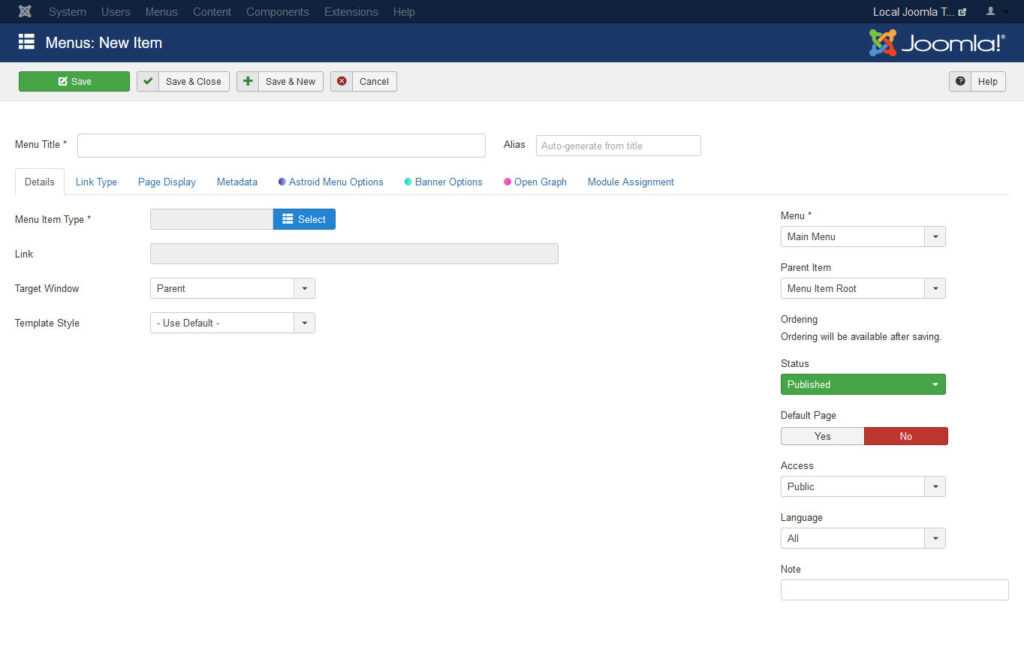[ad_1]
A Beginner’s Guide to Building a Website with Joomla: Step-by-Step Instructions
In the competitive digital landscape, having an online presence is paramount for freelancers, marketing agencies, and businesses of all sizes. While many content management systems (CMS) exist, Joomla stands out for its flexibility and user-friendly interface. This article offers a comprehensive beginner’s guide to building a website with Joomla, ensuring that both novices and experts can easily achieve their business objectives.
Why Choose Joomla?
Before diving into the technical aspects, it’s crucial to understand why Joomla might be the best choice for your project. Joomla is open source, highly customizable, and backed by a robust community and support. It also provides extensive extensions and templates, making it an excellent choice for both simple and complex websites.
Step 1: Prepare Your Environment
Choose a Domain Name
First and foremost, you’ll need a domain name. Choose something that reflects your business or the essence of your website. Platforms like GoDaddy or Namecheap can help you secure a domain name without much hassle.
Select a Web Hosting Provider
Next, you need reliable web hosting. Popular choices include Bluehost, SiteGround, and HostGator. Ensure your chosen provider offers Joomla support—most major hosting providers do.
Set Up a Local Development Environment
To make testing easier and avoid breaking your live site, set up a local development environment. Tools like XAMPP or WampServer can simulate a web server on your local machine.
Step 2: Install Joomla
Download the Joomla Package
Visit the official Joomla website and download the latest CMS package. Save it to a location where you can easily access it.
Upload Files to Your Server
Using an FTP client like FileZilla, upload the Joomla package to your web hosting server. Usually, you’ll upload it to the ‘public_html’ directory.
Create a MySQL Database
Access your hosting control panel (often cPanel) to create a MySQL database and user. Ensure you jot down the database name, username, and password, as you will need these during installation.
Run the Installation Script
Open your web browser and enter your domain name to start the Joomla installation script. Follow the on-screen instructions:
- Configuration: Set the site name, description, admin email, username, and password.
- Database: Input the database details you noted earlier.
- Overview: Review and finish the installation. Delete the ‘installation’ directory as prompted.
Step 3: Customize Your Joomla Site
Templates
Joomla offers numerous free and premium templates. Visit the Joomla Extension Directory (JED) or third-party providers like Joomlart and RocketTheme to find templates that suit your needs. Once downloaded, you can upload and install the template via the Joomla admin panel (Extensions > Manage > Install).
Modules, Plugins, and Components
Joomla’s architecture differentiates between modules, plugins, and components:
- Modules: Often used for small page elements like menus or login forms (Extensions > Modules).
- Plugins: More background tasks like user authentication or content editing (Extensions > Plugins).
- Components: Major applications like contact forms or e-commerce systems (Extensions > Manage).
Customize Template
Once your template is installed, navigate to Extensions > Templates and set your preferred template as the default. Customize it by accessing Template Options. Modify colors, fonts, and layout to fit your brand.
Step 4: Create and Manage Content
Add Menu Items
Create navigable menus by going to Menus > Main Menu. Add items like Home, About Us, Services, and Contact. Each menu item can be tied to a specific piece of content or a functional page like a contact form.
Write Articles
Joomla categorizes content into articles. Navigate to Content > Articles to create new articles. Define the title, content, and category (Content > Categories). Use the editor to format and style your articles, add images, and embed media.
Use Modules to Display Content
Modules can display various types of content or functionality in different positions within your template. For example, a "Latest Articles" module can be added to a sidebar or footer (Extensions > Modules > New).
Step 5: SEO and Performance Optimization
Enable SEO-friendly URLs
Navigate to System > Global Configuration > Site and enable SEO-friendly URLs. This makes your URLs more readable and SEO-friendly.
Optimize Content with Meta Tags
Ensure each article, category, and menu item has relevant meta descriptions and keywords. This can be added directly within the editor or via the Metadata tab.
Use Caching
Enable cache settings in System > Global Configuration > System to improve performance. Additionally, Joomla plugins like JotCache can further enhance site speed.
Step 6: Maintain and Secure Your Joomla Site
Regular Backups
Ensuring the safety of your content and configurations is crucial. Use tools like Akeeba Backup to regularly back up your site.
Routine Updates
Always keep Joomla, its extensions, and templates up to date. Regular updates patch security vulnerabilities and add new features. Navigate to Components > Joomla! Update to check for Joomla updates and Extensions > Manage > Update for extensions.
Secure Your Admin Panel
Security is paramount. Change the default admin URL if possible and use strong, unique passwords. Implement two-factor authentication for another layer of security (Users > Manage > Options).
Step 7: Launch and Promote Your Website
Test All Functionality
Before going live, test every aspect of your site. Make sure that all forms, links, menus, and modules work perfectly.
Deploy to Live Server
Once everything is tested locally, migrate your website to the live server. This can be done manually or using migration tools like Akeeba Backup.
Promote Your Website
Utilize various marketing channels to promote your website. Leverage social media, email marketing, and SEO practices to drive traffic and build a loyal audience.
Conclusion
Building a website with Joomla may seem complex at first, but breaking it down into manageable steps simplifies the process significantly. With its extensive features and flexibility, Joomla offers both beginners and experts the tools needed to create a professional and functional website. By following this step-by-step guide, you’ll not only build a website but also establish a robust online presence, helping you achieve your business objectives.
By focusing on these crucial steps—from setting up your environment to promoting your live site—you can confidently create a professional Joomla website that meets your business goals. Whether you’re a freelancer, running a marketing agency, or an enterprise, Joomla provides a scalable solution for all your web development needs.
[ad_2]


